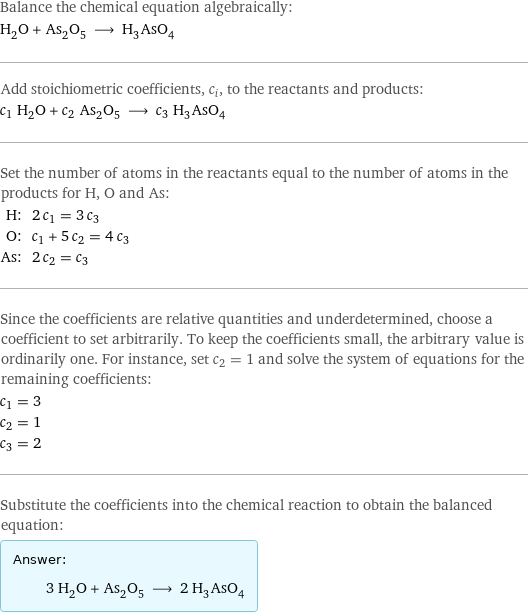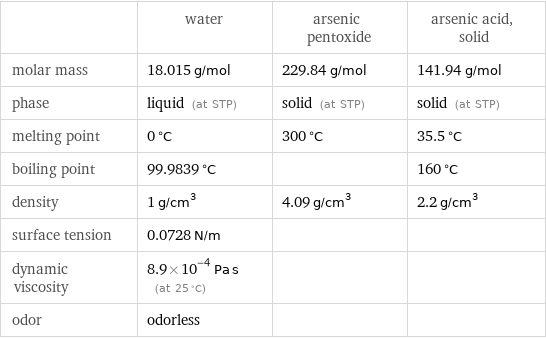Input interpretation

H_2O water + As_2O_5 arsenic pentoxide ⟶ H_3AsO_4 arsenic acid, solid
Balanced equation

Balance the chemical equation algebraically: H_2O + As_2O_5 ⟶ H_3AsO_4 Add stoichiometric coefficients, c_i, to the reactants and products: c_1 H_2O + c_2 As_2O_5 ⟶ c_3 H_3AsO_4 Set the number of atoms in the reactants equal to the number of atoms in the products for H, O and As: H: | 2 c_1 = 3 c_3 O: | c_1 + 5 c_2 = 4 c_3 As: | 2 c_2 = c_3 Since the coefficients are relative quantities and underdetermined, choose a coefficient to set arbitrarily. To keep the coefficients small, the arbitrary value is ordinarily one. For instance, set c_2 = 1 and solve the system of equations for the remaining coefficients: c_1 = 3 c_2 = 1 c_3 = 2 Substitute the coefficients into the chemical reaction to obtain the balanced equation: Answer: | | 3 H_2O + As_2O_5 ⟶ 2 H_3AsO_4
Structures

+ ⟶
Names

water + arsenic pentoxide ⟶ arsenic acid, solid
Reaction thermodynamics
Enthalpy

| water | arsenic pentoxide | arsenic acid, solid molecular enthalpy | -285.8 kJ/mol | -924.9 kJ/mol | -906.3 kJ/mol total enthalpy | -857.5 kJ/mol | -924.9 kJ/mol | -1813 kJ/mol | H_initial = -1782 kJ/mol | | H_final = -1813 kJ/mol ΔH_rxn^0 | -1813 kJ/mol - -1782 kJ/mol = -30.21 kJ/mol (exothermic) | |
Equilibrium constant
![Construct the equilibrium constant, K, expression for: H_2O + As_2O_5 ⟶ H_3AsO_4 Plan: • Balance the chemical equation. • Determine the stoichiometric numbers. • Assemble the activity expression for each chemical species. • Use the activity expressions to build the equilibrium constant expression. Write the balanced chemical equation: 3 H_2O + As_2O_5 ⟶ 2 H_3AsO_4 Assign stoichiometric numbers, ν_i, using the stoichiometric coefficients, c_i, from the balanced chemical equation in the following manner: ν_i = -c_i for reactants and ν_i = c_i for products: chemical species | c_i | ν_i H_2O | 3 | -3 As_2O_5 | 1 | -1 H_3AsO_4 | 2 | 2 Assemble the activity expressions accounting for the state of matter and ν_i: chemical species | c_i | ν_i | activity expression H_2O | 3 | -3 | ([H2O])^(-3) As_2O_5 | 1 | -1 | ([As2O5])^(-1) H_3AsO_4 | 2 | 2 | ([H3AsO4])^2 The equilibrium constant symbol in the concentration basis is: K_c Mulitply the activity expressions to arrive at the K_c expression: Answer: | | K_c = ([H2O])^(-3) ([As2O5])^(-1) ([H3AsO4])^2 = ([H3AsO4])^2/(([H2O])^3 [As2O5])](../image_source/ca9bf53e9fb0e7215ea2effcbd67ef6f.png)
Construct the equilibrium constant, K, expression for: H_2O + As_2O_5 ⟶ H_3AsO_4 Plan: • Balance the chemical equation. • Determine the stoichiometric numbers. • Assemble the activity expression for each chemical species. • Use the activity expressions to build the equilibrium constant expression. Write the balanced chemical equation: 3 H_2O + As_2O_5 ⟶ 2 H_3AsO_4 Assign stoichiometric numbers, ν_i, using the stoichiometric coefficients, c_i, from the balanced chemical equation in the following manner: ν_i = -c_i for reactants and ν_i = c_i for products: chemical species | c_i | ν_i H_2O | 3 | -3 As_2O_5 | 1 | -1 H_3AsO_4 | 2 | 2 Assemble the activity expressions accounting for the state of matter and ν_i: chemical species | c_i | ν_i | activity expression H_2O | 3 | -3 | ([H2O])^(-3) As_2O_5 | 1 | -1 | ([As2O5])^(-1) H_3AsO_4 | 2 | 2 | ([H3AsO4])^2 The equilibrium constant symbol in the concentration basis is: K_c Mulitply the activity expressions to arrive at the K_c expression: Answer: | | K_c = ([H2O])^(-3) ([As2O5])^(-1) ([H3AsO4])^2 = ([H3AsO4])^2/(([H2O])^3 [As2O5])
Rate of reaction
![Construct the rate of reaction expression for: H_2O + As_2O_5 ⟶ H_3AsO_4 Plan: • Balance the chemical equation. • Determine the stoichiometric numbers. • Assemble the rate term for each chemical species. • Write the rate of reaction expression. Write the balanced chemical equation: 3 H_2O + As_2O_5 ⟶ 2 H_3AsO_4 Assign stoichiometric numbers, ν_i, using the stoichiometric coefficients, c_i, from the balanced chemical equation in the following manner: ν_i = -c_i for reactants and ν_i = c_i for products: chemical species | c_i | ν_i H_2O | 3 | -3 As_2O_5 | 1 | -1 H_3AsO_4 | 2 | 2 The rate term for each chemical species, B_i, is 1/ν_i(Δ[B_i])/(Δt) where [B_i] is the amount concentration and t is time: chemical species | c_i | ν_i | rate term H_2O | 3 | -3 | -1/3 (Δ[H2O])/(Δt) As_2O_5 | 1 | -1 | -(Δ[As2O5])/(Δt) H_3AsO_4 | 2 | 2 | 1/2 (Δ[H3AsO4])/(Δt) (for infinitesimal rate of change, replace Δ with d) Set the rate terms equal to each other to arrive at the rate expression: Answer: | | rate = -1/3 (Δ[H2O])/(Δt) = -(Δ[As2O5])/(Δt) = 1/2 (Δ[H3AsO4])/(Δt) (assuming constant volume and no accumulation of intermediates or side products)](../image_source/313f918da2549b109f1995324bb7e332.png)
Construct the rate of reaction expression for: H_2O + As_2O_5 ⟶ H_3AsO_4 Plan: • Balance the chemical equation. • Determine the stoichiometric numbers. • Assemble the rate term for each chemical species. • Write the rate of reaction expression. Write the balanced chemical equation: 3 H_2O + As_2O_5 ⟶ 2 H_3AsO_4 Assign stoichiometric numbers, ν_i, using the stoichiometric coefficients, c_i, from the balanced chemical equation in the following manner: ν_i = -c_i for reactants and ν_i = c_i for products: chemical species | c_i | ν_i H_2O | 3 | -3 As_2O_5 | 1 | -1 H_3AsO_4 | 2 | 2 The rate term for each chemical species, B_i, is 1/ν_i(Δ[B_i])/(Δt) where [B_i] is the amount concentration and t is time: chemical species | c_i | ν_i | rate term H_2O | 3 | -3 | -1/3 (Δ[H2O])/(Δt) As_2O_5 | 1 | -1 | -(Δ[As2O5])/(Δt) H_3AsO_4 | 2 | 2 | 1/2 (Δ[H3AsO4])/(Δt) (for infinitesimal rate of change, replace Δ with d) Set the rate terms equal to each other to arrive at the rate expression: Answer: | | rate = -1/3 (Δ[H2O])/(Δt) = -(Δ[As2O5])/(Δt) = 1/2 (Δ[H3AsO4])/(Δt) (assuming constant volume and no accumulation of intermediates or side products)
Chemical names and formulas

| water | arsenic pentoxide | arsenic acid, solid formula | H_2O | As_2O_5 | H_3AsO_4 Hill formula | H_2O | As_2O_5 | AsH_3O_4 name | water | arsenic pentoxide | arsenic acid, solid IUPAC name | water | | arsoric acid
Substance properties

| water | arsenic pentoxide | arsenic acid, solid molar mass | 18.015 g/mol | 229.84 g/mol | 141.94 g/mol phase | liquid (at STP) | solid (at STP) | solid (at STP) melting point | 0 °C | 300 °C | 35.5 °C boiling point | 99.9839 °C | | 160 °C density | 1 g/cm^3 | 4.09 g/cm^3 | 2.2 g/cm^3 surface tension | 0.0728 N/m | | dynamic viscosity | 8.9×10^-4 Pa s (at 25 °C) | | odor | odorless | |
Units
